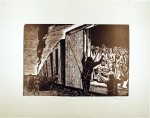
Leopoldo Méndez (1902-1969) was a defining figure in Mexican graphic art and political activism at the turn of the twentieth century. His artistic career began when he attended Academia de San Carlos (San Carolos Academy of Fine Arts). After graduation, he continued his studies at Escuela de Pintura al Aire Libre (impressionistic school for painting “without walls” established by Alfredo Ramos Martinez) located in Chimalista and briefly flirted with Estridentismo (Stridentism) Movement.
Of all his works, Leopoldo was perhaps most famous for the founding of Taller de Gráfica Popular, a studio workshop for a cadre of dedicated politically active graphic artists and muralists. Aligning themselves with the left, the members sought to convey their opinion of a range of social issues through “images in poster, broadside and portfolio forms” [1], many of which took a Surrealist approach of distortion in scale and proportion “to express an emotional response to brutality” [2]. On a local scale, they focused much attention on “las pequeñas cosas cotidianas” (the details of daily life) and portrayed “la lucha diaria” (daily battles) of the peasants and urban poor [3]. Such themes as poverty and oppression of indigenous population became a popular for the movement. On a global scale, Méndez and others members denounced war, imperialism, Fascism, and illiteracy.
It was under such a climate of intense political activism that Méndez created his piece, Deportation to Death, in 1942 as part of El Libro Negro del Terror Nazi en Europa (The Black Book of Nazi Terror in Europe), a 298 page collection of documentary photographs, statistical charts and written accounts of Nazi atrocities written by refugees and others [4]. And it was perhaps, according to art historian David Craven, “one of the earliest attempts by an artist to draw attention to Nazi death camps” [5]. In the foreground, a Nazi soldier is holding a lantern, whose light shines on the faces and bodies of their victims. At the front of this crowd, a hooded old woman sits with her head down, eyes closed, and a downcast expression on her face. Behind her, a group of young women huddle against each other for support and stare fearfully at the soldiers with wide eyes. The man standing in the middle is cradling a baby in his arms with resignation written across his face, a reflection on the fragility of human spirit in the face of inescapable death. Finally, the plume of smoke from the distant locomotives is “eerily evocative of smoke from the crematoria chimneys” [6].
The whole piece was created using linoleum engraving, a medium that gives the artist the ability to vividly capture the inner-working of human psychology as a reaction to their surroundings in an expressive way. By layering black ink on the freshly carved image and pressing it onto a white paper, Leopoldo combined the visual weight of black as well as its boldness with the heavy forms of oppressed individuals [7]. In doing so, he succeeded in capturing the melancholy, despair, and hopelessness on the victims’ faces as they were loaded onto the death train.
Overall, Deportation to Death is the perfect artistic depiction of our identity. It can be seen in a lot of ways as a representation of our continual search and struggle for social justice, equality and freedom not just for ourselves but also for our posterity. Looking at the vivid images of the helpless victims, people cannot help but wonder why some of us allowed that atrocity to happen to fellow human-beings and why such event was allowed to happen. It makes us to realize how precious our everyday peaceful lives are and, more importantly, to take a deeper look at the dark side inside ourselves. And although it may not be pretty, our inner darkness is an important part of our identity and makes us who we are.
HX
References
Leopoldo Méndez, Mexican, 1902-1969, Deportation to Death (Death Train), 1942, Linocut, Ackland Art Museum (2010.48)